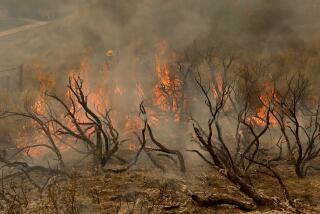Red Tape Bars Planes From Fighting Fires
SACRAMENTO — While San Diego County homes were burning, and state air support was being delayed by a combination of competing demands and communications breakdowns, military aircraft capable of fighting the fires sat idle on runways in Los Angeles and Riverside counties.
Brig. Gen. Raymond Hebrank, commanding general of the California Air National Guard, said five of the guard’s 24 C-130 transports stationed at the Van Nuys Airport and at March Air Force Base could have been equipped as firefighting air tankers in a matter of two hours.
But despite $8.5 million in devastation and the destruction of 64 homes in Normal Heights, no one called for the National Guard’s help because it would have taken 12 to 24 hours to gain permission to use the planes, state and federal officials said.
The request would have been forwarded through a time-consuming maze of federal bureaucracy that involves the U.S. Forest Service, the national Fire Control Center in Idaho, the Pentagon in Washington and the Military Airlift Command in Illinois.
The Normal Heights fire has rekindled questions about the availability of military planes for use in major fires.
Assemblyman Larry Stirling (R-San Diego) said Tuesday the planes could easily have reached the Sunday’s fire before California Department of Forestry contract air tankers did.
Hebrank agreed. “Without the red tape,” the C-130s, which are normally used for transporting men and equipment, can be outfitted as air tankers and sent off on missions in about two hours, he said.
Lt. Col. Victor Rippe, operations chief at the National Guard installation in Van Nuys, said five military air tankers were being prepared Tuesday to fly firefighting missions in Southern California, beginning at daybreak today.
Rippe said the guard had received an “official confirmation message” last night from Air Force headquarters in Washington to fly firefighting missions. Both Van Nuys Airport and March Air Force Base units will participate in the effort, which will be coordinated out of Van Nuys.
But officials with the California Department of Forestry said Air National Guard planes are no good for one-day fires like Normal Heights because of the red tape involved in their activation. Spokesman Mike Harris said in Riverside Tuesday that “as far as I know we could have requested them (the Air National Guard) . . . The problem with that is by the time they’re in the air, it’s the middle of the night and it’s no value.”
Four years ago, after a fire in San Diego County, Stirling complained to then-Gov. Edmund Brown Jr., President Ronald Reagan and Sen. Barry Goldwater (R-Ariz.) about the excessive red tape and the state’s policy of calling for National Guard help only as a last resort.
Stirling also asked for, and got, a state audit, which generally praised the Department of Forestry’s aerial firefighting program. While complimentary about the overall program, the auditor general unsuccessfully sought ways “to reduce the time required to activate the California Air National Guard for aerial firefighting.”
Under certain circumstances, the governor could direct the guard to help in a firefighting emergency, the auditor general concluded. But the governor would not have that authority if the guard was in active federal service, the report added.
Even so, the equipment for converting the military transport planes into air tankers, while kept at National Guard installations, is owned by the U.S. Forestry Service, over which the governor has no control--even in an emergency.
Stirling charged that federal officials have not been inclined to change the awkward and time-consuming policies because of pressure from the private commercial interests that operate air tankers under contract with the Forestry Department. Most of those air tankers are leased from private contractors.
“This is greed taking precedence over public safety,” said Stirling, who said he will raise the issue again when the Legislature’s Joint Committee on Fire, Police, Disaster and Emergency Services holds a special hearing July 29 in San Diego to investigate delays in getting aerial tankers to the Normal Heights fire.
Under their contractual arrangement with the state, Stirling said, the firms stand to lose money if they cannot respond to all fire emergencies.
“Rather than admit that they can’t respond to a request (for aerial tankers), the private contractors will tell the local agencies that they’ll be there, ‘but not right this moment,’ ” Stirling said.
Stirling said his interest in the system was rekindled by delays in getting air tankers to the Sunday fire. Although city officials say they asked for air support before 1 p.m. Sunday, air tankers did not arrive until just before 6:30 p.m., after 50 homes had burned.
But Doug Allen, Forestry Department operations chief at El Cajon, said the air support for the Normal Heights fire wasn’t officially requested until around 4:40 p.m., when two planes were diverted to the blaze from another fire in Ventura County. Don Irvin, deputy director of the state Office of Emergency Services, said his office was notified around 3:58 p.m. that San Diego needed air support. But he said the request was rerouted to Forestry Department firefighters, who eventually responded.
Irvin said it might be nice to have National Guard planes and personnel more readily available, but it would be expensive.
“I don’t know,” he said. “The fire season is here and its going to be here until November . . . It would be nice if we had a full-time force, but it is a costly business.”
More to Read
Sign up for Essential California
The most important California stories and recommendations in your inbox every morning.
You may occasionally receive promotional content from the Los Angeles Times.










